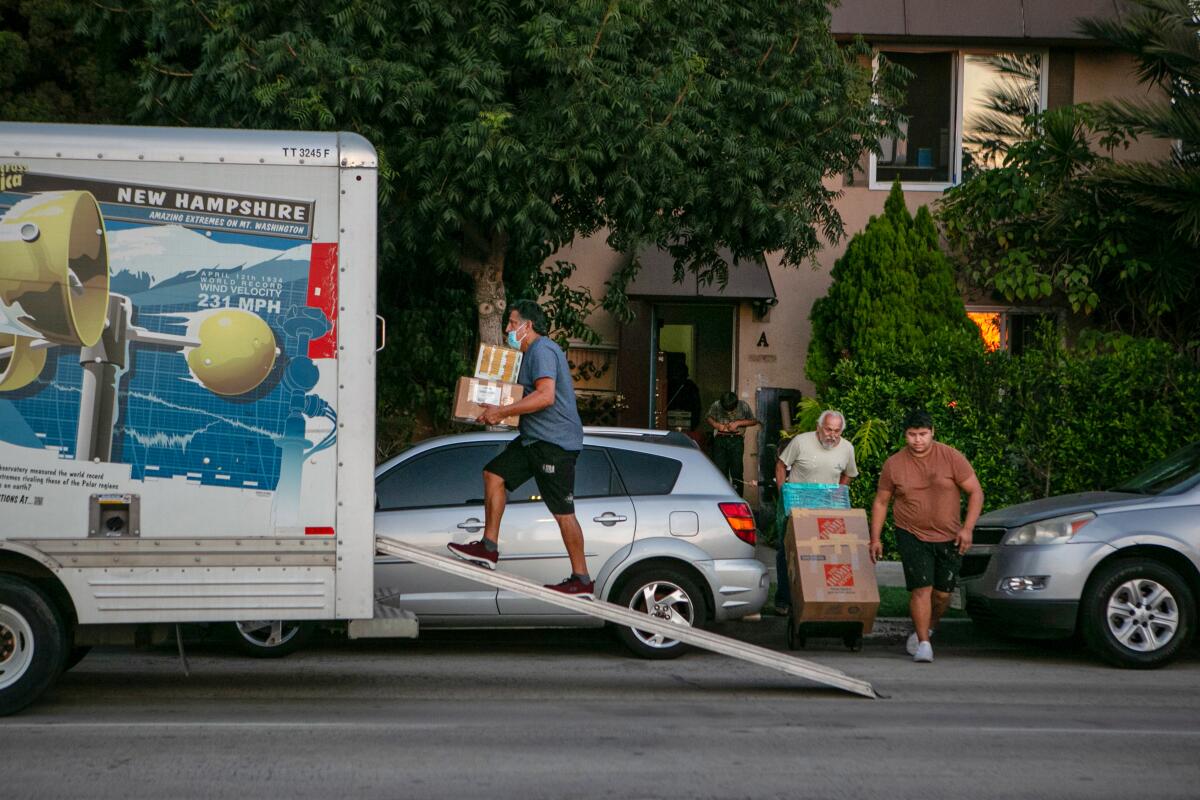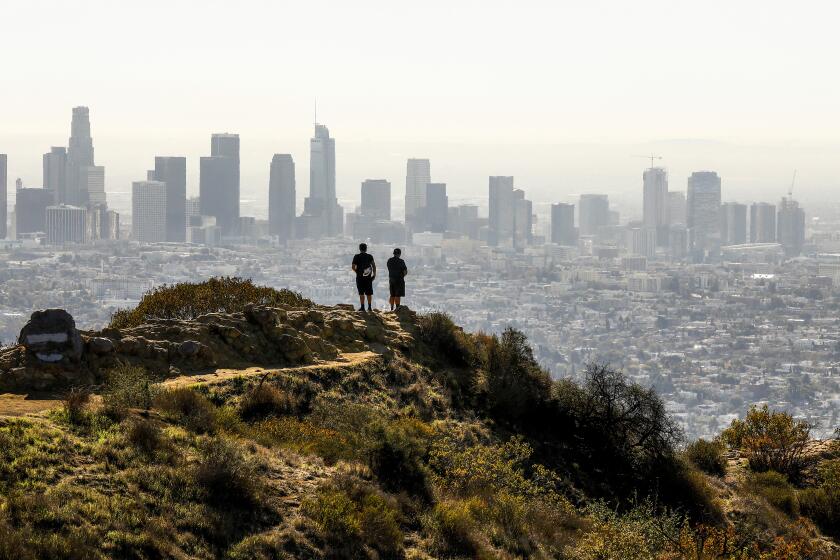Big population drops in Los Angeles, San Francisco transforming urban California

- Share via
Los Angeles and San Francisco saw sizable declines in population during the first year of the COVID-19 pandemic, new census data show, underscoring how California’s housing crisis and other demographic forces are reshaping two of its largest cities.
In terms of total numbers, Los Angeles County lost about 160,000 residents — more than any other county in the nation, the data show. But L.A. County has about 10 million people, so the per capita loss was slightly more than 1% compared with 6.7% in San Francisco and 6.9% in New York.
“We are in this new demographic era for California of very slow or maybe even negative growth,” said Hans Johnson, a demographer with the Public Policy Institute of California. “And it does have implications for everything in our state — from how we live our lives to which schools are getting closed down to how much capacity we might need for transportation networks, and eventually to housing.”
The data, published Thursday by the U.S. Census Bureau, show California as a whole saw a net loss of nearly 262,000 residents between July 1, 2020, and July 1, 2021, with the lion’s share of the losses coming from Los Angeles County: 159,621 people. The second-largest countywide loss in the nation was New York, which declined by about 111,000 residents.
The findings paint a picture of a state in flux, with factors such as soaring home prices, dwindling birth rates and more work-from-home options contributing to a population on the move.
The state’s population declined by 173,000 between July 2020 and July 2021, bringing the estimated total population to 39.37 million.
“This loss that both California is experiencing and Los Angeles County is experiencing are kind of the perfect storm from a demographic perspective, and all the components that lead to population change are all trending in a downward direction for both the state and Los Angeles,” Johnson said.
Nearly all of the state’s population loss was driven by domestic migration, data show, meaning most people who are leaving are choosing to go — often seeking more affordable housing and job opportunities, or moving with family.
Jena Lords said she and her husband discussed leaving Bakersfield for several years because they were unhappy with the direction the state was going. They decamped to Idaho last year.
“The top reason was 2nd Amendment rights,” said Lords, 39. “There’s also the high cost of living, tax fees, regulations.”
Lords and her husband both had stints in the firearms industry, she said. To them, it felt as though “the governor didn’t want us to be able to defend ourselves.”
The pandemic provided a rare opportunity for the pair to move — Lords had been working remotely as a department coordinator at Cal State Bakersfield and her husband quit his job in November 2020. Last spring, she accepted a position as an administrative assistant at Idaho State University.
She and her husband lived in their recreational vehicle for 10 months before closing escrow on a $140,000 home sitting on half an acre of land in Pocatello, about an hour south of Idaho Falls, two months ago.
The surge of migration eastward fits a pattern of families escaping densely populated cities, a trend that dates back to the mid-20th century.
“The hardest thing was leaving our friends and family — and the beach, of course,” Lords said. “It’s amazing, the difference in culture. It’s a real small-town feel.”
California overall lost about 367,000 people like the Lords to domestic migration — a number higher than the net loss, which includes gains from births and other sources. Los Angeles lost about 180,000 to domestic migration
The census numbers underscore population losses the state has faced in recent years. The state lost a seat in Congress for the first time in history due to sluggish population growth.
It seemed like an unusual choice — turning from the city that has long been a beacon for immigrants from Latin America and Asia, in favor of a tiny Central Valley town called Huron.
The Bay Area, where skyrocketing housing costs have long been a major problem, was hit particularly hard. San Francisco lost about 54,000 residents and Santa Clara County — home to Silicon Valley — 45,000 people.
But more affordable parts of Southern California, such as Riverside and San Bernardino counties, saw growth during this period, including people coming from other areas. Riverside saw the third-highest population gain in the nation with about 36,000 new residents, following only Maricopa County, Ariz., and Collin County, Texas, according to the data.
California was also among the minority to see a “natural increase” in the population, or more births than deaths during that one-year period, the data show. More than 73% of U.S. counties experienced natural decrease in 2021.
Yet natural increase is also slowing both nationally and within California. The state reported 91,996 more births than deaths from July 2020 to 2021, according to the census data, but that number was about 262,000 in 2015.
And while the state saw a net gain in international migration — about 14,300 people moved to California from abroad — the number is also significantly lower than what it was in recent years. About ten years ago, Los Angeles County received close to 50,000 people through international immigration. This year, the county reported only about 4,000.
Some city dwellers who’ve moved to the high desert over the last year and a half looking for more space and clean air also found unexpected drawbacks.
“All those factors are operating together now in ways that we’ve never seen before,” said Johnson, the demographer. “We’ve had periods with large domestic out-migration, but not at the same time that we saw this big decline in foreign immigration and a slowdown in natural increase. So when you add all those things together, that adds up to population losses both for the state and for Los Angeles that are very, very unusual demographically.”
Although the COVID-19 pandemic probably played a role in less immigration, the number of international migrants has been steadily declining for several years, said Paul Ong, director of the Center for Neighborhood Knowledge at UCLA.
“It’s a combination of those things, but certainly it was happening before the pandemic,” Ong said. “In some ways, it’s part of what we see historically in terms of immigrants — that they do settle and cluster in a few areas and cities, but over time they move away. And when they move away, they sponsor new relatives coming in further away from the original core.”
A shrinking population can have a negative effect on the local economy and can mean fewer skilled workers, Ong said.
For some, the decision to leave California grew out of mounting frustration and a desire for change.
“I started seeing the homeless population increasing and nothing being done about it,” said former Southern California resident Alfredo Malatesta, who immigrated to L.A. from Peru as a child. “It was starting to remind me of where I left many years before.”
He and his wife, Erin, moved from Santa Clarita to Tennessee in 2017, and have taken a shine to rural life outside Nashville.
“You feel like everyone is out to screw you in a way in a city like Los Angeles. And for the amount I pay to live here, the taxes, the infrastructure falling apart ... everything is just like constantly like you’re getting screwed,” Malatesta, 43, said.
After sitting down and mapping out the future, the couple decided they wanted some distance from the “fatigue” they felt in L.A. — and a new adventure with a simpler life.
“I kept telling myself that my wife and I can’t live here happily, and the system is counterproductive and not efficient. It’s harder and harder to run a business when these stresses are pressing down on you,” he said. “It doesn’t seem like Los Angeles has an identity anymore.”
More to Read
Sign up for Essential California
The most important California stories and recommendations in your inbox every morning.
You may occasionally receive promotional content from the Los Angeles Times.
















